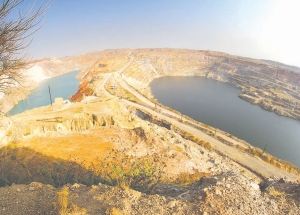The storm of the financial crisis is now behind Katanga Mining (KAT-T) and the company is looking to its operational strength to rebuild its balance sheet.
Katanga — which was on the brink of ruin when the financial crisis first struck due to a copious amount of debt and a collapsing copper price — is now priming up for a strong 2010 thanks to its copper and cobalt mine in the Democratic Republic of the Congo.
The company reported gross profit of $16.8 million and net income of $15.3 million for the fourth quarter of 2009 with profits being built on sales revenue of $100 million.
That tidy sum came from the sale of 10,275 tonnes copper and 680 tonnes cobalt, which brought in cashflows from operations of $15.5 million.
Such strong financials came from operations like its KTO underground mine — 329,703 tonnes at 3.84% copper and 0.53% cobalt — and the T17 open pit, which mined 658,120 tonnes averaging 1.08% copper and 0.93% cobalt.
The company’s Kamoto concentrator processed 581,876 tonnes of ore to produce 54,782 tonnes of concentrate while its Luilu proce ss i n g plant produced 13,382 tonnes copper and 824 tonnes cobalt.
For the entire year, Katanga managed to churn out 41,964 tonnes copper and 2,534 tonnes cobalt production, with the bulk coming in the latest quarter.
Katanga said that from the first quarter to the fourth, copper production increased to 13,382 tonnes from 8,715 tonnes, while cobalt production was up to 824 tonnes from 487 tonnes.
But to reap those production benefits later in the year, Katanga had to complete large financings earlier in 2009.
First it raised $100 million by issuing convertible debt that was subsequently turned into equity; then it raised another $250 million through a rights offering in July.
The deal left metals trader Glencore with a significant stake in the company and rights to buy metals at market-discounted prices.
The year was also eventful for the company thanks to its coming to terms with DRC state mining conglomerate, Gécamines. The two companies signed a joint venture agreement at the end of July — a signing that coincided with the successful completion of the painfully drawn out mining-licence review by the DRC government.
As for what investors can expect from the company going forward, Katanga forecasts production of 82,000 tonnes of copper cathode and 5,500 tonnes of cobalt metal in 2010.
The company also updated the status of its “accelerated development plan” that aims to take production capacity up to 150,000 tonnes copper and 8,000 tonnes cobalt per year.
Katanga says the ramp-up will be finished by the second quarter of 2011 and that it will fund the development with cash flows from operations.
In Toronto on Feb. 8 — the day the financial results were released — Katanga shares were up 7% or 5¢ to 69¢ on 606,000 shares traded.


Be the first to comment on "Katanga Springs Back To Life"